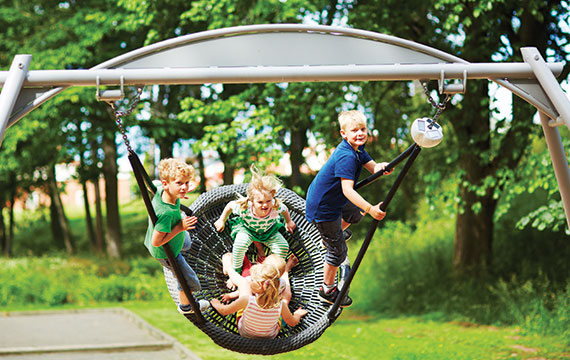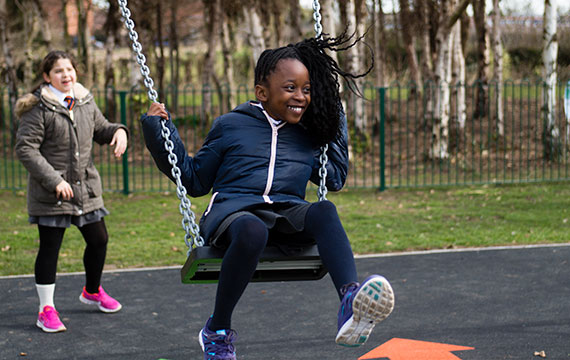Leitfaden für die Auswahl einer Spielplatzschaukel
Schaukeln sind seit langem eine beliebte Einrichtung auf öffentlichen Spielplätzen, die von allen anerkannt und geschätzt wird. Die Bewegung des Schaukelns bereitet sowohl Kindern als auch Eltern Freude und fördert das Lachen und die Bindung, was sich positiv auf die körperliche und geistige Gesundheit auswirkt.
Experten sind sich einig, dass sich Schaukeln positiv auf die Entwicklung von Kindern auswirken, die Körperwahrnehmung fördern und ein Gefühl von Glück und Zugehörigkeit vermitteln. Trotz ihrer Einfachheit müssen Schaukeln hohen Anforderungen an Spielwert und Sicherheit genügen.
In diesem Leitfaden werden wir fünf Dinge behandeln, die bei der Auswahl einer Spielplatzschaukel zu beachten sind.
1. Wahl der richtigen Größe der Spielplatzschaukel
Achten Sie bei der Auswahl einer Schaukel auf die freie Fallhöhe und den Fallraum, der auf unseren Produktseiten als "Platzbedarf" angegeben ist. Die freie Fallhöhe ist der übliche Punkt, von dem ein Benutzer fallen könnte, während die Fallfläche die Sicherheitszone um das Gerät herum ist, die frei bleiben muss. Diese Maße bestimmen den gesamten Platzbedarf und den erforderlichen Bodenbelag, was sich auf die Installationskosten auswirkt.
So erfordert beispielsweise eine größere Fallhöhe einen dickeren Belag, um Stöße zu absorbieren. Außerdem erfordert ein größerer Schwenkrahmen einen größeren Sicherheitsbereich, um Kollisionen mit anderen Geräten zu vermeiden.
Beispiele für Schwingungsgrößen
2. Die Wahl des richtigen Schwingsitzes
Wählen Sie den Schaukelsitz je nach Altersgruppe und Anzahl der Benutzer. Für sehr junge Kinder oder solche mit geringer Kernstabilität sorgen Sitze mit zusätzlicher Rückenlehne für Sicherheit. Korbschaukeln sind ideal für ältere Kinder, die soziale Interaktion suchen, da sie Platz für mehrere Benutzer bieten und eine kostengünstige Option darstellen. Darüber hinaus ermöglichen Korbschaukeln das gemeinsame Spielen von Kindern mit unterschiedlichen Fähigkeiten und bieten Kindern mit Behinderungen zusammen mit ihren gesunden Freunden oder Betreuern eine bequeme Fahrt.
Auswahl Schwingsitz
3. Auswahl der Schaukelmaterialien
Die Wahl des Materials ist entscheidend und hängt von der gewünschten Ästhetik und dem Wartungsbedarf ab. Schaukeln aus Holz fügen sich harmonisch in ländliche Umgebungen ein und werden von Architekten und Grünflächenämtern bevorzugt, die ein natürliches Ambiente anstreben. Für moderne, kühne Designs, die die städtische Architektur ergänzen, sind Schaukeln aus Stahl ideal. Stahl ist außerdem leichter zu pflegen und widerstandsfähiger gegen Vandalismus, so dass er sich gut für anspruchsvolle städtische Gebiete eignet.
Schaukeln nach Material
4. Sicherheitsmerkmale berücksichtigen
Einige unserer Schaukeln sind mit "Anti-Wrap"-Lagern am Querträger ausgestattet, um zu verhindern, dass sich die Schaukelsitze und -ketten um sich selbst wickeln und die Schaukeln unbrauchbar machen. Die Stratus-Designs enthalten eine zusätzliche Kette, die für zusätzlichen Halt sorgt.


5. Auswahl eines Standorts für Ihre Schaukel
Beachten Sie beim Aufstellen einer Schaukel die allgemeinen Sicherheitsrichtlinien. Stellen Sie das Gestell in einem sicheren Abstand zu anderen Spielgeräten, Wegen und Toren auf, um das Risiko von Zusammenstößen zu minimieren. Achten Sie darauf, dass sich keine Landschaftselemente wie Sträucher, Bäume oder Felsbrocken in der Nähe befinden, da diese eine Gefahr darstellen können, wenn Kinder von der Schaukel fallen oder unvorsichtig um sie herumlaufen.




















